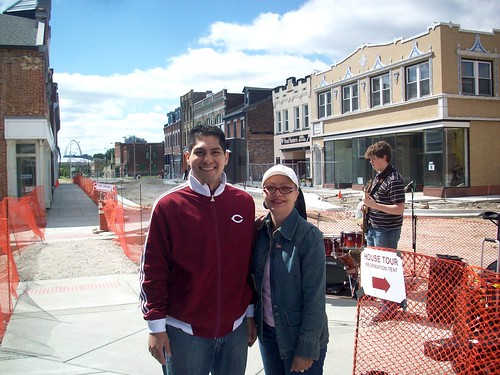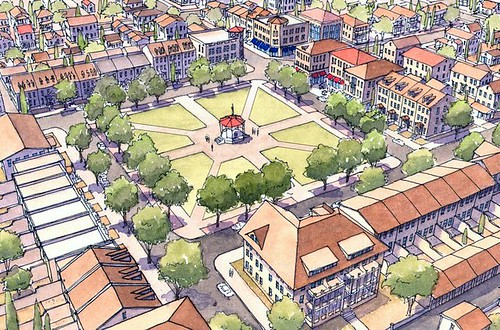National models of inclusive revitalization, smart planning, green building honored by EPA

Posted December 2, 2011 at 1:32PM
One of the country’s very best, grassroots-led revitalizing neighborhoods and one of our most articulate city plans for a more sustainable future are among this year’s five national honorees for achievement in smart growth, awarded by the federal Environmental Protection Agency. The other very worthy winners include a green learning center in a small South Dakota town, a green, affordable apartment building in New Mexico, and an innovative civic gathering space in Illinois.
This year marks the tenth annual EPA smart growth awards (I also wrote about last year’s awards) and, in my opinion, perhaps the best so far.
Old North Saint Louis
I have been singing the praises of Old North Saint Louis for over three years now, ever since a presentation I gave to a conference led one of the architects involved in the neighborhood’s restoration to send me some materials. I have since followed the project very closely and gotten to know a number of the principals, and my enthusiasm has only increased. I knew that the neighborhood was among the finalists for this year’s awards (I was on the jury that selected the finalists, though Old North was not in the category I had responsibility for), and was really hoping it would receive the recognition it deserves.
Tragically, in the mid to late 20th century, Old North became one of the country’s most disinvested urban neighborhoods, losing over 90 percent of its population while its buildings were abandoned. But, gradually and with determination, the neighborhood-based Old North St. Louis Restoration Group and the Regional 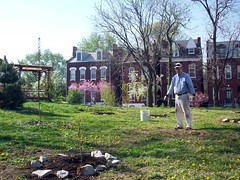 Housing and Community Development Alliance worked with residents and newcomers to rehab the district’s great housing stock; build new homes in character with the old; host block parties, house tours, a farmer’s market, and a food co-op; install history and poetry trails (a poetry trail!); plant community gardens; and undertake an award-winning rebuild of the neighborhood’s badly decayed commercial district.
Housing and Community Development Alliance worked with residents and newcomers to rehab the district’s great housing stock; build new homes in character with the old; host block parties, house tours, a farmer’s market, and a food co-op; install history and poetry trails (a poetry trail!); plant community gardens; and undertake an award-winning rebuild of the neighborhood’s badly decayed commercial district.
Although Old North was all-too-recently considered by many to be a place to avoid, there is nowhere in the region that this writer would now rather be. Here’s how I began what became the first of at least four articles on Old North:
“Every now and then I run across a story that is so good, that feels so right, that I thank my lucky stars for the freedom NRDC gave me to evolve my career into working for better, more sustainable communities. This is such a story, and it reveals an historic, diverse, inclusive neighborhood that is reclaiming its identity, restoring its infrastructure, empowering its residents, and securing its future. The community wins, and so does the environment, because the Old North neighborhood in Saint Louis is the very antithesis of sprawl.”
I’m not backing off. We are lucky to have other great revitalization stories in America, but I don’t know a better one. ONSL won for “overall excellence.” (I have lots of photos, maps, images and detail in my previous writing on the subject, linked above.)
Plan El Paso
I have also had the honor of writing about Plan El Paso, an impressively undertaken and articulated blueprint for how that Texas border city is planning to use transit and neighborhood-building to secure a more sustainable future. If I haven’t seen a better urban restoration-in-progress than Old North, I’m not sure I have seen a better vision (at least not in the US) to guide a sprawling, automobile-oriented place into smarter development patterns than the work in El Paso. The city should be proud, and so should my friend Victor Dover and his colleagues at Dover Kohl Town Planners, which helped the city with the planning process.
Earlier this year, I profiled a precursor to the plan called Connecting El Paso. If readers will indulge another shameless self-reference, here’s a bit of how the work impressed me (along with a note of caution):
“A blog post can’t possibly capture all the rich detail of Connecting El Paso, which is meticulous on such subjects as walkability, street connections, public spaces, complete streets, environmental remediation, green stormwater infrastructure, community character, further transit investment, historic preservation, public policy needs, and even the application of LEED-ND. More than just a collection of area and [transit-oriented development] blueprints, this document is nothing less than a comprehensive guide to smart growth design and implementation in a major US (and international) city.
“It must be said, however, that the sorry history of land use in America is littered with terrific plans that for one reason or another were not implemented to their potential or, worse, overridden and fractured by ad hoc amendments. This is long range stuff that will require sustained financial capital and political will over decades to succeed.”
The point I made then and will reiterate now is that, to succeed, you need something to aim for. There is no question that this plan has provided the right aspirations and guidance on how to get there. Last January, somehow I had the prescience to write about the El Paso planning effort, "when this year’s architectural and planning awards are handed out, look for it among the likely honorees." It is a deserving winner in the “programs, policies and regulations” category.
Maroney Commons
The winner in the rural category comes from Howard, South Dakota, population 850. Maroney Commons is a mixed-use, LEED-platinum-certified complex and “rural learning center” containing a hotel, a conference center, 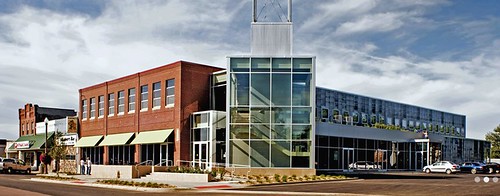 a restaurant, and offices that will help rural residents learn about green jobs and technology.
a restaurant, and offices that will help rural residents learn about green jobs and technology.
Catalyzed by the growth of the wind energy industry in surrounding Miner County, the Commons is the product of a community visioning process that led straight to the revitalization of Howard’s Main Street. EPA’s citation says this about the building’s green achievement:
“One of the first LEED Platinum-certified buildings in South Dakota, the building has solar panels, a wind turbine, geothermal heating and cooling, porous outdoor pavement, rainwater capture and storage, and native landscaping. Materials gathered from demolished Main Street buildings were recycled and reused during construction; the wood floor from an old gymnasium is now the floor of the restaurant, and Maroney Commons’ siding came from an old American Legion hall. Real-time, touch-screen displays of the wind and solar energy produced at the building help visitors understand these technologies.”
Eighty percent of South Dakota’s population lives within 100 miles of Howard, making the center accessible to many small-town residents. EPA also notes that the facility hosts design:South Dakota, a team of architects and community development experts who travel statewide helping residents reimagine their rural communities through design workshops.
Silver Gardens Apartments
In Albuquerque, another LEED-platinum building is putting affordable apartments near reliable transportation options, helping low-income residents save money on energy, transportation, and housing. Silver Gardens houses 66 mixed-income homes and was built by the Supportive Housing Coalition of New Mexico in partnership with developer Romero Rose (an affiliate of Jonathan 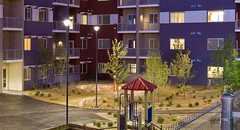 Rose Companies). Financing was assisted by the city’s $30-million Workforce Housing Trust Fund and the state’s Mortgage Finance Authority.
Rose Companies). Financing was assisted by the city’s $30-million Workforce Housing Trust Fund and the state’s Mortgage Finance Authority.
Silver Gardens has an abundance of state-of-the-art green building features, enabling it to be the first affordable housing project in the nation to sell carbon offsets. But EPA’s citation makes clear that the project’s building characteristics form only the start of its smart growth credentials:
“The project is on a reclaimed brownfield — a former bus depot and repair shop along a main commercial street in central Albuquerque. Restaurants, shops, museums, theaters, schools, and other amenities are all within easy walking and biking distance, and the transportation center across the street is the hub for city and regional buses, regional light rail, and train service. The building, designed with the input of nearby residents to ensure that it fits into the surrounding neighborhood, provides much-needed workforce housing in Albuquerque’s downtown, which was important to the business community.”
A 15,000-square-foot courtyard provides a playground, picnic space, native landscaping, and artwork for the benefit of residents and visitors.
As a condition of its financing through the Workforce Housing Trust Fund, Silver Gardens will maintain its affordable housing status for at least 90 years. In addition, revenue received in state tax credits for the building’s LEED Platinum status helps provide supportive assistance for Silver Gardens’ low-income residents, including an on-site social services coordinator.
Uptown Normal Roundabout
Originally conceived just to manage traffic, the Uptown Normal (Illinois) Roundabout, winner in the civic places category, has evolved into a gathering place that increases business for local merchants.
The anchor for a community-wide revitalization that has earned LEED-ND recognition, the roundabout (which deserves a name worthy of a community anchor, in my opinion) does more than you might think any traffic facility can do for a town. Here’s EPA:
“Normal, Illinois, has transformed a busy five-way intersection into a roundabout and an attractive, green civic space. The roundabout moves traffic at lower, more predictable speeds, which reduces the time vehicles spend idling and the areas with potential for crashes. The result is a safer and more efficient traffic flow with less air pollution due to fewer emissions. The roundabout design complements the multimodal transportation station the town is currently constructing next to it with a U.S. Department of Transportation grant. The station, which will eventually have high-speed rail service, and the roundabout take advantage of existing infrastructure, bus service, and the town’s historic central business district.
“The one-third-acre roundabout does much more than move cars. It invites pedestrians with shade trees, benches, lighting, bike parking, green space, and a water feature. People have lunch, read, and play music, and the open space invites community gatherings such as a holiday caroling event.”
To my eyes, it’s the interaction with the community, not the facility itself, that earns this award. Farr Associates guided the planning effort for the city.
My organization, the Natural Resources Defense Council, has had a long association with EPA’s smart growth (now sustainable communities) office. Even during the Bush years, we – and others, from the National Association of Realtors to private developers to academic institutions to local and state government agencies – worked together in a cooperative partnership with the office. They have made a difference time and again for the environment with a softer, nonregulatory but very important approach that stresses research and partnership. Their annual awards program is one of my favorite professional occasions, and never more so than this year.
Congratulations to this year’s winners, about which you can read more on EPA’s website.
I’ll leave you with a video showing the Old North Saint Louis restoration in progress, focusing on the commercial heart of the historic district. The video is now a couple of years old, but it still captures the neighborhood’s history and can-do spirit:
Move your cursor over the images for credit information.
This post first appeared in The Atlantic Cities.
